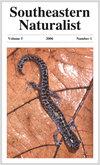佛罗里达州西南部住宅区地鼠龟的运动生态学
IF 0.6
4区 环境科学与生态学
Q4 BIODIVERSITY CONSERVATION
引用次数: 0
摘要
摘要/ Abstract摘要:Gopherus polyphemus(地鼠龟)是一种联邦濒危物种,由于其种群数量的显著下降,主要是由于栖息地的丧失和破碎化。许多地鼠龟生活在受人类影响和城市化地区的私人土地上,但这些种群对物种保护的价值尚不清楚。我们对佛罗里达州开普科勒尔的一个居民区的地鼠龟种群进行了一项无线电遥测研究,以确定它们是否能从城市环境中的位置中受益(即,它们是否是“城市爱好者”)。一些研究结果表明,这些陆龟可能生活在城市环境中。在为期一年的研究中,10只陆龟中没有确认死亡,尽管有一只雄性陆龟从该地区散去,6个月后消失了。雌性(n = 5)和雄性(n = 4)的年平均家园范围(100% MCP)分别为1.19 ha(最小最大值:0.39 ~ 2.71 ha)和1.13 ha(最小最大值:0.51 ~ 1.72 ha),与自然生境的家园范围大小相当。然而,其他研究结果表明,这种城市景观限制了动物的数量。地鼠龟很少穿越道路(占所有活动的5%),并避开有房屋和相关人类建筑的地段,喜欢未开发的地段。在城市环境中维持这些动物的努力可以开始实施管理策略,将城市景观中的绿地作为保护这种受威胁物种的额外方法。该研究表明,成年地鼠象对高度城市化和人为干扰具有适应性和耐受性,但其在这些景观中的持续程度有待进一步探索。本文章由计算机程序翻译,如有差异,请以英文原文为准。
Movement Ecology of Gopher Tortoises in a Residential Neighborhood in Southwest Florida
Abstract - Gopherus polyphemus (Gopher Tortoise) is a federally listed or state threatened species throughout its range due to significant declines in its populations, largely due to habitat loss and fragmentation. Many Gopher Tortoises reside on private lands in human-impacted and urbanized areas, yet the value of these populations to the conservation of the species is unclear. We conducted a radio-telemetry study on a population of Gopher Tortoises in a residential neighborhood in Cape Coral, FL, to determine if they could be benefitting from their location within an urban environment (i.e., whether or not they are “urbanophiles”). Some findings suggested that these tortoises could exist in an urban environment. There were no confirmed mortalities among the 10 tortoises in the year-long study, though 1 male dispersed from the area and later disappeared after 6 months. The mean annual home ranges (100% MCP) were 1.19 ha (min–max: 0.39–2.71 ha) for females (n = 5) and 1.13 ha (min–max: 0.51–1.72 ha) for males (n = 4), which are comparable to home-range sizes in natural habitats. However, other findings suggested that this urban landscape limited the animals. Gopher Tortoises rarely crossed roads (5% of all movements) and avoided lots with houses and associated human structures, in favor of undeveloped lots. Efforts to sustain these animals in urban environments can start implementing management strategies that integrate greenspaces within urban landscapes as an additional approach to protect this threatened species. This study suggests that adult Gopher Tortoises are adaptable and tolerant to high levles of urbanization and human disturbance, yet the degree to which tortoises can persist over time in these landscapes needs further exploration.
求助全文
通过发布文献求助,成功后即可免费获取论文全文。
去求助
来源期刊

Southeastern Naturalist
环境科学-生态学
CiteScore
1.20
自引率
16.70%
发文量
31
审稿时长
18-36 weeks
期刊介绍:
The Southeastern Naturalist covers all aspects of the natural history sciences of terrestrial, freshwater, and marine organisms and the environments of the southeastern portion of North America, roughly bounded from North Carolina south to Florida, west to Texas, north to Oklahoma, and east back to North Carolina. Manuscripts based on field studies outside of this region that provide information on species within this region may be considered at the Editor’s discretion.
 求助内容:
求助内容: 应助结果提醒方式:
应助结果提醒方式:


